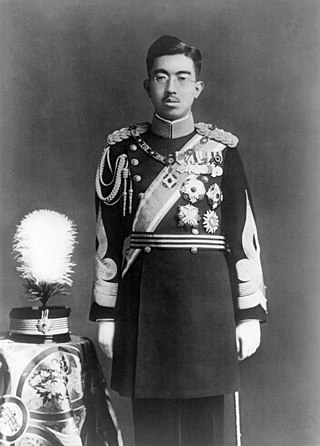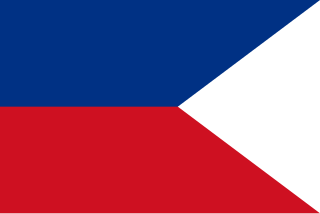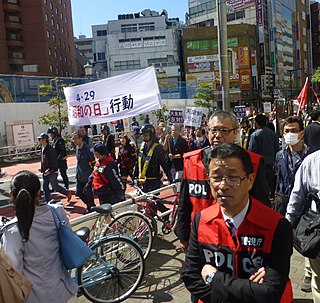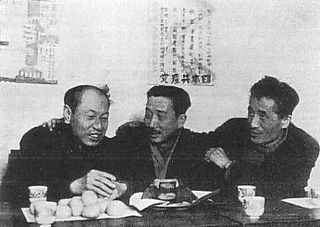Anti-monarchism in Japan was a minor force during the twentieth century.
Anti-monarchism in Japan was a minor force during the twentieth century.
In 1908, a letter allegedly written by Japanese revolutionaries denied the Emperor's divinity, and threatened his life. [1] In 1910, Kōtoku Shūsui and 10 others plotted to assassinate the Emperor. [2] In 1923, 1925 and 1932 Emperor Hirohito survived assassination attempts. [3]
After World War II, the communists were antagonistic to the Emperor. The Japanese Communist Party demanded the abolition of the emperor system. [4] They boycotted the formal opening of the National Diet in 1949 because of Emperor Shōwa's presence. [5] The Japanese Communist Party continued to be antagonistic after Emperor Shōwa's death in 1989. [6]
During the Imperial visits to Otsu, Japan in 1951, and Hokkaido in 1954, Communist posters and handbills antagonistic to the Imperial Family Members were plastered in the cities. [7] [8]
In 1951, three thousand students in Kyoto University protested against Emperor Shōwa's continued reign. [9]

Hirohito, posthumously honored as Emperor Shōwa, was the 124th emperor of Japan, reigning from 1926 until his death in 1989. Hirohito and his wife, Nagako, had two sons and five daughters; he was succeeded by his fifth child and eldest son, Akihito. By 1979, Hirohito was the only monarch in the world with the title "Emperor". He was the longest-reigning historical Japanese emperor and one of the longest-reigning monarchs in the world.

Japan was occupied and administered by the victorious Allies of World War II from the surrender of the Empire of Japan on September 2, 1945 at the end of the Second World War until the Treaty of San Francisco took effect on April 28, 1952. The occupation, led by the American military with support from the British Commonwealth and under the supervision of the Far Eastern Commission, involved a total of nearly one million Allied soldiers. The occupation was overseen by the U.S. General Douglas MacArthur, who was appointed Supreme Commander for the Allied Powers by the U.S. President Harry S. Truman; MacArthur was succeeded as supreme commander by General Matthew Ridgway in 1951. Unlike in the occupation of Germany and the occupation of Austria, the Soviet Union had little to no influence over the occupation of Japan, declining to participate because it did not want to place Soviet troops under MacArthur's direct command.

Kōtoku Denjirō, better known by the pen name Kōtoku Shūsui , was a Japanese socialist and anarchist who played a leading role in introducing anarchism to Japan in the early 20th century. Historian John Crump described him as "the most famous socialist in Japan".

The Shōwa era, [ɕoːwadʑidai] was the period of Japanese history corresponding to the reign of Emperor Shōwa from December 25, 1926, until his death on January 7, 1989. It was preceded by the Taishō era and succeeded by the Heisei era. The pre-1945 and post-war Shōwa periods are almost completely different states: the pre-1945 Shōwa era (1926–1945) concerns the Empire of Japan, and post-1945 Shōwa era (1945–1989) concerns the State of Japan.

Sakai Toshihiko was a Japanese socialist. He advocated opposition to the Russo-Japanese War, founded the Heiminsha and published the newspaper Heimin Shimbun. He formed the Japan Socialist Party and the Japanese Communist Party, and became the first general secretary of the Japanese Communist Party. His pen name is Saka Kosen (堺枯川). He is also known for his translation with Kōtoku Shūsui.

The Supreme Commander for the Allied Powers (SCAP) was the title held by General Douglas MacArthur during the United States-led Allied occupation of Japan following World War II. It issued SCAP Directives to the Japanese government, aiming to suppress its "militaristic nationalism". The position was created at the start of the occupation of Japan on August 14, 1945.

Kanson Arahata, real name Katsuzō Arahata, was a Japanese politician and writer active in the socialist and labor movements. Born in Kanagawa Prefecture, he converted to socialism in 1904 while working at the Yokosuka Naval Arsenal, where he read anti-war pamphlets by Kōtoku Shūsui, Sakai Toshihiko, and other socialists. After the Russo-Japanese War, Arahata wrote for numerous socialist publications; his account of the Ashio Copper Mine incident is considered a classic of Japanese journalism. In 1922, Arahata helped found the Japanese Communist Party. After World War II, he served on numerous labor committees, and was elected the first chairman of the National Trade Union of Metal and Engineering Workers. He also helped found the Japan Socialist Party in 1945, joining its Central Committee in 1947 and winning elections to the National Diet on its slate in 1946 and 1947. In 1948, Arahata's opposition to the party's approval of postal, tobacco tax, and train fare increases led him to leave its ranks. After a failed attempt to create a new socialist party, he lost his seat in the Diet in the 1949 election. In 1951, Arahata withdrew from active involvement in the socialist and labor movements, but continued to write and exercise influence. He died in 1981.

Shōwa Day is a public holiday in Japan held on April 29. It honors the birthday of Emperor Shōwa (Hirohito), the reigning emperor from 1926 to 1989. Shō (昭) means "shining" or "bright", and wa (和) means "peace", signifying the "enlightened peace" that citizens receive. According to the now defunct Democratic Party of Japan, the purpose of the holiday is to encourage public reflection on the turbulent 63 years of Hirohito's reign, ranging from totalitarianism to the post-war reconstruction and transition into a democratic state.

Socialist thought in Imperial Japan appeared during the Meiji period (1868–1912) with the development of numerous relatively short-lived political parties through the early Shōwa period. Left wing parties, whether advocating communism or socialism, provoked hostility from the mainstream political parties, oligarchs and military alike, and many were either banned or went underground soon after formation. Although occasionally winning a seat in the lower house of the Diet of Japan, left-socialist parties played little role in the government of the Empire of Japan.
The High Treason Incident, also known as the Kōtoku Incident, was a socialist-anarchist plot to assassinate the Japanese Emperor Meiji in 1910, leading to a mass arrest of leftists, and the execution of 12 alleged conspirators in 1911.
The Toranomon incident was an assassination attempt on the Prince Regent Hirohito of Japan on 27 December 1923 by communist agitator Daisuke Nanba.

Kyuichi Tokuda was a Japanese politician and first chairman of the Japanese Communist Party from 1945 until his death in 1953.
Anarchism in Japan began to emerge in the late 19th and early 20th centuries, as Western anarchist literature began to be translated into Japanese. It existed throughout the 20th century in various forms, despite repression by the state that became particularly harsh during the two world wars, and it reached its height in the 1920s with organisations such as Kokuren and Zenkoku Jiren.
Iwao Yamazaki was a lawyer, politician and cabinet minister in the early Shōwa period of Japan. His brother, Tatsunosuke Yamazaki was also a politician and cabinet minister, and his nephew Heihachiro Yamazaki was later a prominent member of the post-war Liberal-Democratic Party.

Political dissidence in the Empire of Japan covers individual Japanese dissidents against the policies of the Empire of Japan.

Yoshio Shiga was a member of the Japanese Communist Party.
Shoichi Ichikawa was a Japanese Communist Party member. He was born in Yamaguchi Prefecture on 20 March 1892. He joined the party in January 1923. He was arrested in April 1929. He died in prison in March 1945.

Political prisoners in Imperial Japan were detained and prosecuted by the government of the Empire of Japan for dissent, attempting to change the national character of Japan, Communist activity, or association with a group whose stated aims included the aforementioned goals. Following the dissolution of the Empire of Japan after World War II, all remaining political prisoners were released by policies issued under the Allied occupation of Japan.

During the 1920s and 1930s, there were three known assassination attempts on Hirohito, the Emperor of Japan. The assailants were all either Korean or Japanese. Assassination attempts on Hirohito took place throughout his reign as Prince regent, and Emperor of Japan. All of their attempts failed. All four would-be assassins were sentenced to death, though one was granted amnesty and eventually released, and one committed suicide in prison.